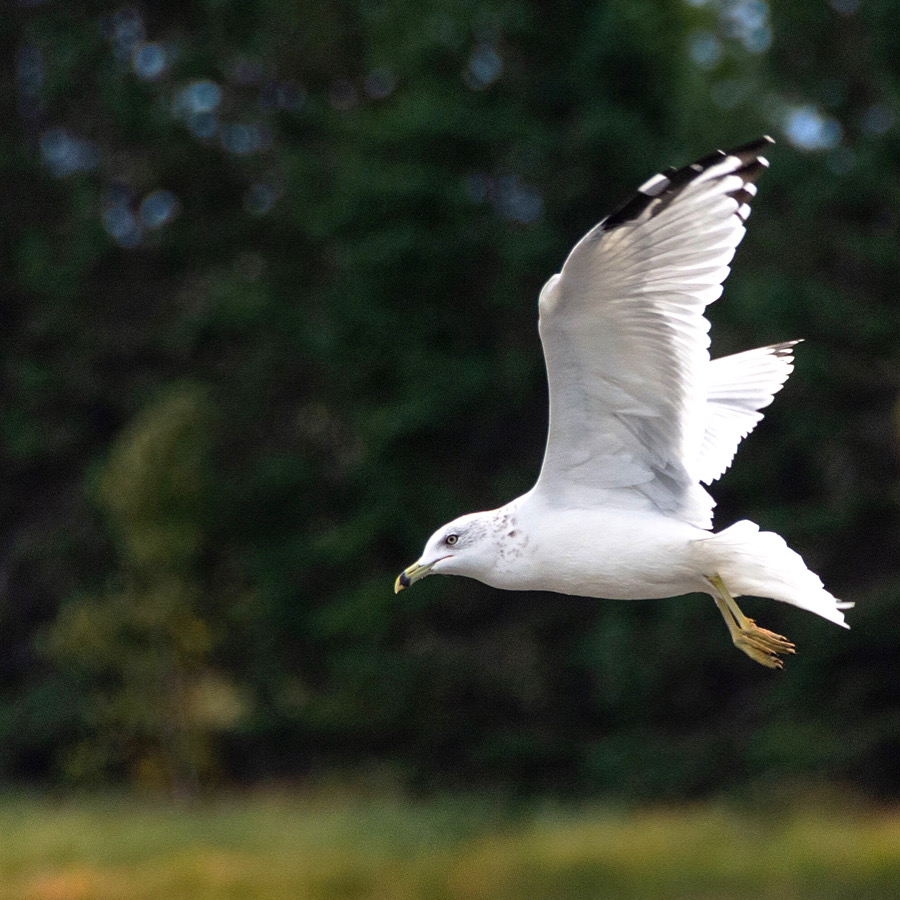Ring-billed gulls are one of North America’s most prominent birds. You’ve likely seen them foraging on coastal beaches, in parking lots, or garbage dumps. Believe it or not, they were exceptionally rare at the beginning of the 20th century. In 1916, they were given protective status and their population has since recovered and numbers several million in North America. In fact, a single colony can be 20 – 80,000 pairs!

Identification
The ring-billed gull is a medium-sized bird. It is mostly white, but has pale grey wings with black tips. They look similar to herring gulls, but have a distinctive black ring that circles the tip of their yellow beak. They also have yellow feet, not beige-pink like the herring gull.
Habitat
Ring-billed gulls can nest on a number of surfaces including sand, driftwood, stone, pebble, and soil. They’ll nest on oceanic islands and sometimes freshwater peninsulas. One study found that landfills were important nesting sites for urban gulls.
Diet and Living Near Humans
The diet of ring-billed gulls varies by location, season, and weather. A study published in the mid-1970s, showed that ring-billed gulls survived on earthworms, fish, and insects. They’re also known to feed on seeds, grains, nuts, fruit, and other birds.
Human garbage is another source of food for them. This is why they do well in close proximity to cities and other populated areas. In the mid-1990s, scientists conducted a study on the diet of ring-billed chicks in urban and non-urban colonies in Quebec. It showed that “the main items in the chicks’ diet were, in decreasing order of importance, garbage, anthropods, earthworms, fish, and small mammals.” In urban areas, gulls fed on household waste. In rural areas, gulls ate waste from poultry farms.
Interestingly, chicks communicate “honest signals” about their nutritional needs through the intensity and frequency of their calls, and by pecking.
Monogamy, Polygyny, and Female-Female Pairs
Ring-billed gulls typically “form monogamous, heterosexual pairs during the breeding season.” Both parents are responsible for incubating eggs and feeding nestlings. They also work together to build nests and keep away potential intruders. While both males and females play a role in brood and territorial defence, males play a more aggressive role.
A small percentage of ring-billed gulls form polygynous (1 male with multiple females) and female-female pairings. In these cases, all members help in incubation and care of chicks.
Female-female pairings had larger clutches, but lower success rates with hatching. It’s unclear why their success rates are lower. A study published by the Waterbird Society found, male “gulls did not appear to provide any unique component of parental care that two females paired together could not provide.”
Reaction to Predators
Ring-billed gulls react differently to predators depending on whether the predator is targeting them, their young, or their eggs. Generally speaking, when adult gulls are targeted they’ll take flight and leave the colony site. When their eggs or young are the target, they will mob predators by swooping down and hitting them with their feet before soaring back into the air. Ornithologists call this technique “swoop-and-soar.”
Reaction to predation changes based on the breeding season. Conover and Miller showed that during the pre-incubation period, gulls approached by predators would fly away from the colony. During egg-laying season, gulls fled only if other gulls were being attacked. During incubation, gulls endured some predation of other adults before fleeing. Finally, when their chicks were hatched, ring-billed gulls tried to move their young away from predation.
Common predators include birds of prey, foxes, coyotes, raccoons, and cats.
More Bird Posts
Want to learn more about birds? Check out some of my other posts:
Why Do Birds Sing in the Early Morning?
Nuthatches: The Birds that Walk Upside Down
References
Ingrid Pollet, Dave Shutler, John Chardine, John Ryder. “Larus delawarensis.” The Cornell Lab of Ornithology.
Jean-François Giroux, Martin Patenaude-Monette, Florent Lagarde, Ericka Thiériot, Pierre Brousseau, and Pierre Molina. 2016. “The Rise and Fall of Larus delawarensis in Eastern North America.” Waterbirds.
William Jarvis and William Southern. 1976. “Food Habits of Ring-Billed Gulls Breeding in the Great Lakes Region.” The Wilson Bulletin.
Tanya Dewey and Janice Pappas. “Larus delawarensis.” Animal Diversity Web.
Brousseau, Lefebvre, and Giroux. 1996. “Diet of Ring-Billed Gull Chicks in Urban and Non-Urban Colonies in Quebec.” Waterbird Society.
Michael Conover, Don Miller, and George Hunt. 1979. “Female-Female Pairs and Other Unusual Reproductive Associations in Ring-Billed and California Gulls.” Oxford University Press.
John Ryder and Patricia Somppi. 1979. “Female-Female Pairing in Ring-Billed Gulls.” The Auk.
Michael Conover. 1989. “Parental Care by Male-Female and Female-Female Pairs of Ring-Billed Gulls.” Waterbird Society.
Michael Conover and Don Miller. 1979. “Reaction of Ring-Billed Gulls to Predators and Human Disturbances at at Their Breeding Colonies.” Waterbird Society.
Linda Southern. 1981. “Sex-Related Differences in Territorial Aggression by Ring-Billed Gulls.” Oxford University Press.
Anne-Marie Dulude, Georg Baron, and Raymond McNeil. 1987. “Role of ale and Female Ring-Billed Gulls in the Care of Young and Territorial Defense.” Canadian Journal of Zoology.
Jerrold Beland, Sheri Ickes, and Thomas Seamans. 1999. “Importance of Landfills to Urban-Nesting Herring and Ring-Billed Gulls.” Landscape and Urban Planning.